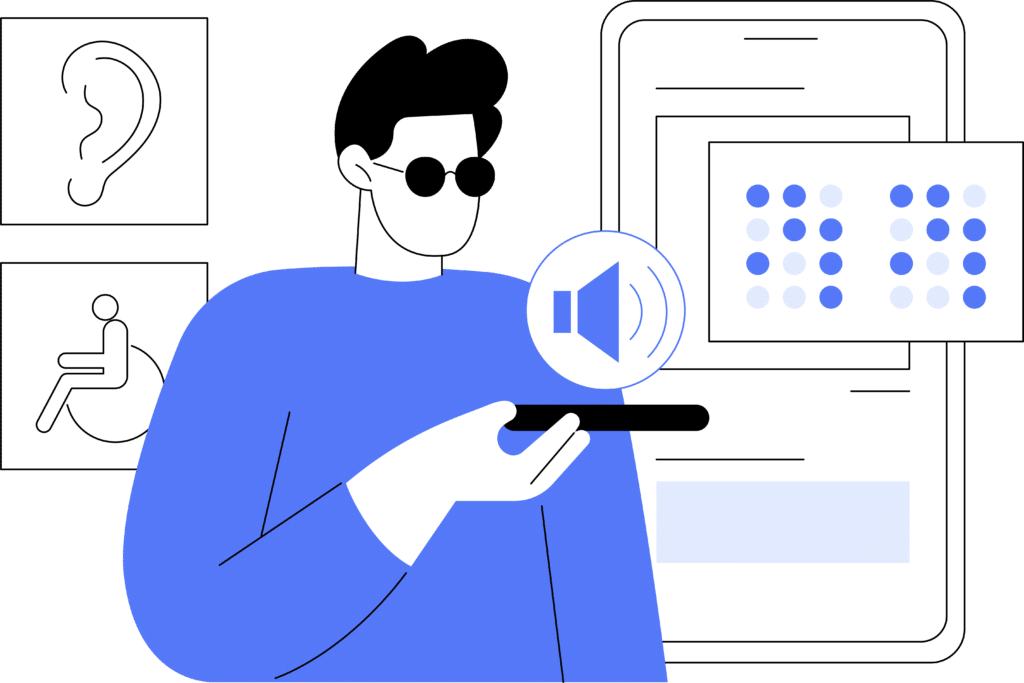Discover how the availability of digital products can bring your business greater reach and better SEO.

Senior UX/UI Designer

Accessibility of digital products (accessibility) has been an incredibly trendy word recently. Wherever you turn your ear in the IT world, you hear accessibility here, there, everywhere and so on. But what is it and what is this famous accessibility?
AvailabilityAs the name says, the digital product created is usable by anyone, regardless of a person's limitations. This means that a typical Smith will be able to access our website or application and click on what he needs, but the same possibility will be available to a person with limited vision (or no vision at all), who is deaf or simply elderly (and I remind you, each of us will belong to this group one day).
More often than not, however, inexperienced or uninformed businessmen and businesswomen, to put it brutally, marginalise or completely downplay the accessibility needs of products, claiming that people with special needs are not their target group and will not 'kill themselves' for the few percent. It's just that these few percent are more than a billion people worldwide (according to WHO), and 4.7 million citizens in Poland alone (speaking only of people with various forms of disability, not including the elderly).
But okay, let's recognise that none of these almost 5 million people are theoretically in the target group for the product. So why am I getting so hung up and winded about this accessibility when it's not needed? Well, because accessibility is not just about securing more customers. It is followed by much more. And to encourage you to read on - implementing accessible digital products translates into HAJS!

All countries of the European Union (yes, Poland counts), have adopted Directive 2019/882 (summary of the here), referred to as European Accessibility Acti, according to which by 28 June 2025 most digital products and services must comply with accessibility standards in line with the WCAG 2.1.
WCAG 2.1 - a set of guidelines for implementing digital products that qualify as accessible, according to 4 principles: perceivability, functionality, comprehensibility and robustness. Among these, recommendations can be found on:
and many others...You can find the content of these standards for example here
The directive applies to a multitude of digital solutions, but does not apply to websites or content not updated after 28 June 2025 and to micro-businesses providing services. That is, if you're planning to liquidate your business or go bankrupt by this deadline, or don't feel like growing, then you don't need to mess around with implementing these strange recommendations 😉 But if you're thinking of expanding further, implementing the directive's guidelines will allow you to avoid the additional costs of not having regulations or even processes in place. And let's establish, no one smiles at running a business with officials panting on their necks.
SEO - a beautiful phrase familiar to every marketer. After all, who doesn't want their website to be at the very top of search engine keywords? If SEO isn't your thing or indifferent, then neither should accessibility. The application of accessibility standards has a significant impact on your site's SEO. Both concepts (SEO and accessibility) focus on optimising websites and improving the user experience. Implementing an accessible product improves SEO metrics such as time spent by a user on a page, organic traffic or the rejection rate (i.e. it reduces the number of times a customer has decided to leave a page before performing the action we want, such as making a purchase). And this is because a significant proportion of accessibility recommendations are also SEO best practices. This includes elements like:

If your business is not the only one in this category in the market, then you know full well that you have to 'fight' for customers and visibility. SEO is just one component of building recognition. However, when you take extra care to meet the specific needs of your customers, you will definitely gain in the eyes of users, especially if your competitors still haven't done so. Who wouldn't want to attract an extra 5 million customers and promote themselves as an empathetic and inclusive brand? And remembering whisper marketing - if one more person is satisfied with your services, they are likely to tell more potential customers about you. Win-win
Here is the hardest thing that few people realise - implementing accessibility standards is not just about taking care of permanently disabled people. In fact, every user benefits. And to make it easier for you to understand the topic:
These are just some of the examples where everyone could benefit from accessibility, and where taking care of accessibility standards will make life easier not only for people with disabilities, but also for the aforementioned typical Joe Smith.
Of course, the topic is not exhausted and one could discuss accessibility, the value it provides, implementation standards and use cases for hours. Especially since this topic comes back like a boomerang and you can expect to hear about it again soon. However, I hope I have succeeded in raising awareness about accessibility, sparking your curiosity and maybe even encouraging you to take the first step towards ensuring digital business inclusivity.

Delve deeper into the subject:
https://www.gov.pl/web/dostepnosc-cyfrowa/
https://kinaole.co/dostepnosc-ecommerce/

Senior UX/UI Designer